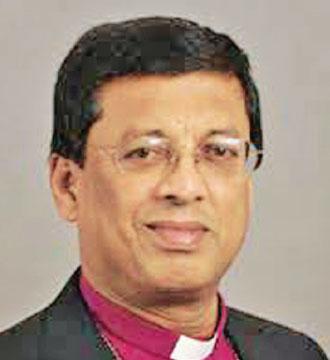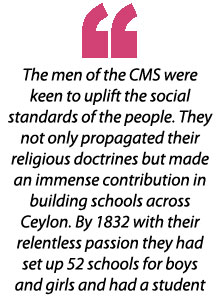
Freedom of religion enshrined in the Constitution has yielded amazing results. For decades this island has been a nation of peace loving citizens who embraced ethnic and religious diversity. As we know the British administrators wielded their influence on the maritime provinces, and by 1815 Ceylon was very much within their control.
 During the time of Governor Sir Robert Brownrigg, in 1817, the first four missionaries sailed to our shores. Prior to this the Bible Society had been established in Ceylon in 1812. Over the next few years these pioneering churchmen built mission houses in Colombo, Kandy, Jaffna, Kotte and Baddegama. It is said, the journey of a thousand miles begins with one step, and these men took that step of faith and endured a long voyage to Ceylon.
During the time of Governor Sir Robert Brownrigg, in 1817, the first four missionaries sailed to our shores. Prior to this the Bible Society had been established in Ceylon in 1812. Over the next few years these pioneering churchmen built mission houses in Colombo, Kandy, Jaffna, Kotte and Baddegama. It is said, the journey of a thousand miles begins with one step, and these men took that step of faith and endured a long voyage to Ceylon.
The voyages, navigating through inclement weather often took between five to six months. Today, as we reflect on two centuries of their good work, in the field of church work and education we remain thankful to these men of indomitable faith and vision.
Origins of the CMS
The Church Missions Society has a beautiful heritage, tracing its roots back to 1799. The initial idea to form such a society was proposed by Charles Grant and George Uday of the East India Company.
Others who endorsed the CMS vision were William Wilberforce, Charles Simeon and Rev. David Brown who was already serving in Calcutta, India. The CMS works within the Anglican Communion, representing the Anglican Church, often referred to as the Church of England.
During those early days the clergymen came to our exotic island. Ceylon was made a Crown Colony in 1802. Prior to this, when the Dutch were ruling they suppressed the work of the Catholic priests, threatening them with death. It is ironic that their own Article 7 of 1656 guaranteed religious liberty to the Catholic friars.
The first colonial chaplain was the Anglican Rev. James Cordiner followed by Rev. Twisleton, Rev. George Bisset, Rev. J.M.S. Glennie and Rev. Benjamin Bailey.
It is recorded that in 1805 Governor Fredrick North provided a building for Christian worship in the Fort area. The prudent men who supported the work of the CMS were Governors Robert Brownrigg, Edward Barnes, James Campbell and Robert Horton. By 1817 the Baptist Mission had a church in Grandpass and the Wesleyan Methodist Mission had founded Richmond College, Galle in 1815.
This was followed by Methodist Central College, Batticaloa and Newstead Girls’ School in Negombo (1816). By July 1816 American Mission Board had established Union College, Tellippalai, and a few years later they set up Uduvil Girls’ School.
The bold and compassionate Anglican missionaries first set sail to Ceylon, leaving Britain on December 20, 1817.
They were blessed by their mentor Rev. J.W. Cunningham. The men reached the port of Galle on June 29, 1818. They had spent almost 200 days at sea. Upon arrival Rev. Joseph Knight went towards the north, to Nellore (present day Nallur, Jaffna). Rev. Robert Mayor journeyed to Baddegama.
The green hills of Kandy beckoned Rev. Samuel Lambrick, while Rev. Benjamin Ward found solace in Calpentyn (present day Kalpitiya). It is interesting to note that Rev. Ward delivered his first sermon in Sinhalese in August 1819. It had taken him two years to master the native language.
Living in the land of the palmyrah trees Rev. Joseph Knight began to interact with the people, learning their culture.
In 1820, he was assisted by Rev. Joseph Bailey who delivered sermons in the Tamil language, which awed the rural folk. By 1823, they had established St. John’s College, Jaffna with seven students. At one time it was an English seminary. It remains one of the finest boys’ schools in the Northern Province. After successfully setting up the Mission House in Kandy, Rev. Samuel Lambrick returned to Colombo.
Bangala Handiya
He was keen to set up another church. He had hired a raft and sailed along the Kelaniya River and stumbled upon a bare land, in Kotte. He set up a Mission House, with a few bungalows.
These ancient homes gave the name of ‘bangala handiya’ (junction of bungalows) in Kotte, which is still used.
In this era religion and education were linked closely. Records indicate that the Archdeacon Rev. James Glennie was appointed Secretary of the Schools Commission. During this time the Bishop of Calcutta Rt.Rev. Reginald Herber visited Ceylon and spent five weeks, understanding the mission work carried out in the island.
The men of the CMS were keen to uplift the social standards of the people. They not only propagated their religious doctrines but made an immense contribution in building schools across Ceylon. By 1832 with their relentless passion they had set up 52 schools for boys and girls and had a student register of 1,810 pupils.
The CMS aim was to ‘dispel the darkness of ignorance and illiteracy’. It built and maintained schools out of its own funds. In 1925 the church established the Diocesan Board of Education.
These Anglican schools still operate, and over the years, hundreds of thousands have gained a holistic education. To this day, parents compete to enrol their children in these schools which include St. John’s College, Jaffna, Chundikuli Girls’ College Jaffna, Hillwood College Kandy, Mowbray College Kandy, St. Thomas Prep School, Kollupitiya. S. Thomas’ College, Mount Lavinia, Bishops College and Ladies’ College, Colombo and Trinity College, Kandy, to name a few.
The pioneering clergy were keen to ‘inculcate the spirit of Christ and influence the youth to become worthy citizens’.
In 1833, Rev. Lambrick (one of the first 4 pioneers) made an important contribution by setting up a printing press. William Riddesdale was got down from England to print the first English - Sinhala dictionary. They were assisted by Rev. John Haslam. In 1857 Rev. John Ireland opened a school in Kandy for boys. By 1872 it was reopened as Trinity College.
Ms. Bellarby arrived in Ceylon and was able to set up Hillwood College Kandy in May 1890. Mary Carter began a school with just nine girls and named it Chundikuli Girls’ College, in 1896.
There were only two students at Fairfield House when Lillian Nixon and Elizabeth Whitney founded Ladies College at Union Place in 1900. In 1910 they shifted to Flower Road, Colombo 7.
Churches of the CMS
The men and women of the CMS invested their time and money to establish houses of divine worship. The forerunner to the CMS was the SPG (Society for the Propagation of the Gospel) established in 1701 in England.
During 1839 the first wave of unskilled men came from South India to work in Ceylon’s tea estates. Among them were a second tier of men who worked as clerks, store keepers and horse keepers.
By 1854, the CMS stationed in Thinnevelly sent trained catechists to Ceylon to minister to these humble folk. The first four Tamil clergy who came were Joseph, Anandam, Vethanayagam and Gnanamuthu.
These zealous souls walked to Kandy to reach the Mission House! In this era the clergy serving the plantation workers were at risk of getting jungle fever, chickenpox and nettle rash.
The early Anglican priests walked 20 miles a day on average to visit the various tea estates.
Tamil Bibles and hymns books were sent from India, although Rev. Peter Percival and Arumugam Navalar had done a Tamil translation. This unique Bible was destroyed in the arson at the Jaffna Library.
As records indicate the Anglicans in Ceylon came under the care of the Bishop of London from 1798- 1814. With the formation of the Diocese of Calcutta in 1813 we came under this leadership. Finally in 1845 the Diocese of Colombo was created with Rt. Rev. James Chapman as the first Bishop.
It was Bishop Chapman who began S. Thomas’ College at Mutwal (Colombo 15) in 1851, and also built the Cathedral Church in 1854 on the same premises. The school later shifted to Mount Lavinia. The late Rev. C. Devasagayam was a key personality in setting up the Leprosy Hospital.
During this time Rev. Cornelius Senanayake was active in the Panadura and Moratuwa areas which paved the way for Holy Emmanuel Church.
The Anglican Bishop of Colombo Rt. Rev. Dhiloraj Canagasabey said, “From our vantage point 200 years later, we look back in wonderment at the motivation and sacrifice of these men, who left the comfort of everything they considered home.
They undertook a long and perilous sea voyage half way across the world. They did not enjoy benefits of advanced healthcare, transport and instant communication.
They worked with commitment faithful to the call to proclaim the good news of the Lord Jesus”.
Thus the CMS has transfigured and impacted our nation with divine excellence.
